
STATE OF THE ART 2020
5 September until 31 October 2020
From 1 November onward, STATE OF THE ART 2020 is only accessible in its text version. If you are interested in the digital tour through the exhibition space, please do not hesitate to contact us via email kontakt (at) galeriepostel.de
For full enjoyment of the text version of STATE OF THE ART, please click on the images – further information and images are hidden behind many of them.
Links in the text connect to former exhibitions of the artist at galerie postel
works are listed in alphabetical order by artist
Any questions? We are happy to help!
kontakt (at) galeriepostel.de
Tel.: +49-40-22 85 39 24 – 0
for anything from information on works and artist’s biographies to prices or further material
Amer Al Akel
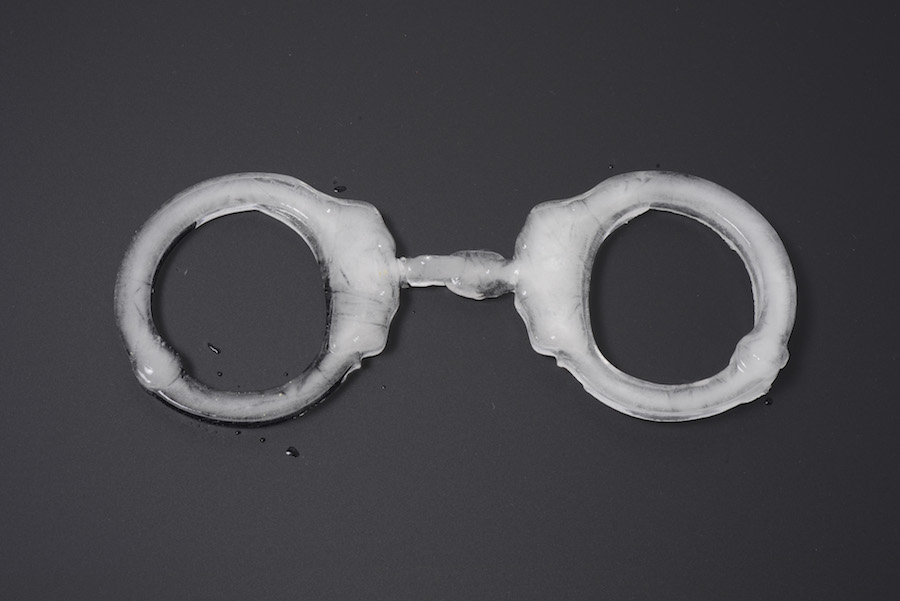
Melting Their Power, 2020
lenticular print
60 x 90 cm
Please click on the image to start the video!
The most recent work by Amer Al Akel, „Melting their Power“, transfers the artist’s conceptual approach into the printing technique and still bears the same handwriting as did his contributions to the IN BETWEEN exhibition where an oversized game of chess, neon letters and a relief sculpted from Aleppo Soap made their point in a multitude of media that themselves were carriers of meaning.
Melting – that is the process the handcuffs made from frozen water undergo. The ephemeral process is documented in a video file and conserved in print. What meaning do the handcuffs imply? The artist deliberately leaves the question to the viewer. One thing, nevertheless, can be said concerning the lenticular technique: Whether the handcuffs are still there or not is a matter of perspective…
Ari Goldmann
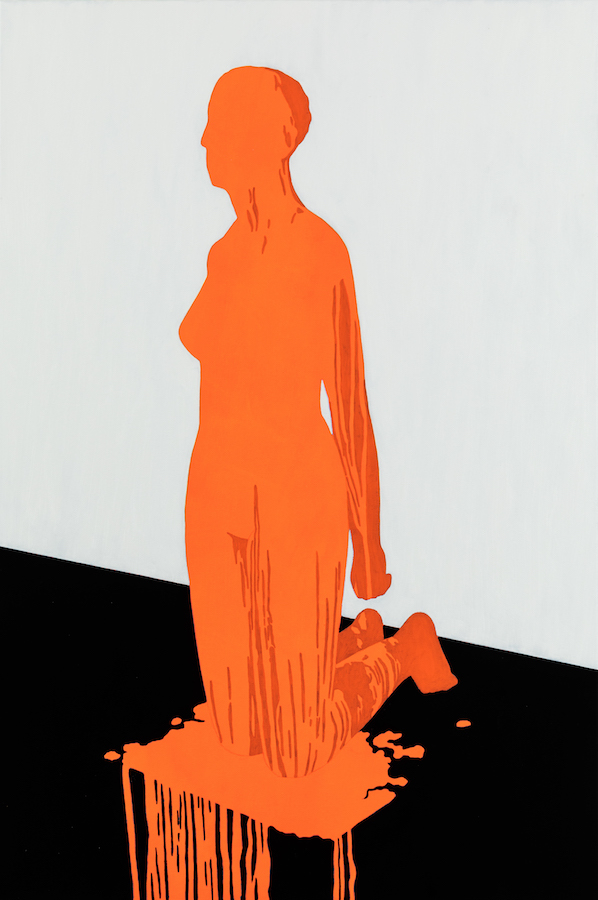
Weep, 2020
oil and acrylic on canvas
80 x 120 cm
She is kneeling close to the edge, apparently naked but nevertheless barely recognizable by contour or features. Wet from something running down her body in shining neon orange.
Why? What are the circumstances? Why is she kneeling? Is she hurt? What is running down her body? And why has she not raised her arms to protect herself when she was obviously hit by something? She keeps her arms behind her back, helplessly giving in, presenting herself to the opponent, incapable of fleeing or to ward off the violent act. Is she free in her actions? Or forced to do so? Ari Goldmann keeps the viewer in the dark.
Most of Goldmann’s other paintings are based on images derived from the media, from books and newspapers. Through these he reflects upon the use of archetypal iconographic forms of our collective memory. But this time a photo the artist himself took, served as basis to the painting.
It was taken about a year ago, when the sculpture „big kneeling woman“ by Georg Seitz was vandalised in an attack using paint. The sculpture is kneeling at the end of a stone bench at the Alster walk close by the Alster meadows, a popular recreation area in Hamburg. She surmounts the seated flaneurs. The attack nevertheless contradicts any impression of free will or relaxation. The passive gesture might have been interpreted differently in the sixties when the sculpture was made, but where does one kneel as obedient as this while being abused?
Weep – the title transmits the amount of sadness the artist sees in this situation. As in his other works Ari Goldmann deletes any context relating to time and place in the process of abstraction, even the graffiti with its political implications that was applied to the bench during the attack. Reduced to its outlines the gesture of the figure becomes prominent as universal signifier.
This is not the single sculpture violated on a specific place in Hamburg, it is the universality of violence and passivity, of vulnerability and sadness in face of the violence that in the brightness of the neon colour sticks out from the black and white of the painting’s background.
Kathrin Haaßengier
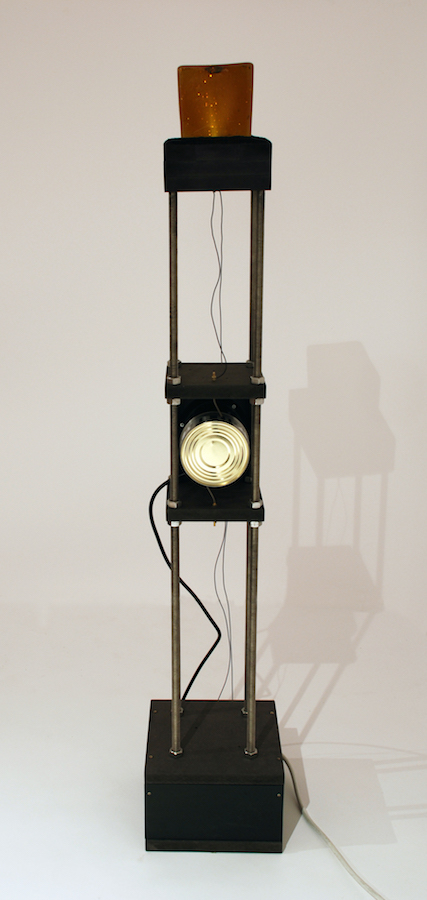
liebelebe, 2020
wood, metal, glas, bulb, motor
140 x 21 x 21 cm
Please click on the image to start the video!
The latest work by Kathrin Haaßengier sends a signal of hope into the darkness: The bulb beneath the brownish glass cube blinks the morse code l i e b e l e b e (l o v e l i v e). By this Kathrin Haaßengier connects to the tradition of her earlier work while at the same time contradicting it completely.
In the exhibitions
„magnetic love“ and
„Probella“ at galerie postel sculptures, induced by energy and carefully selected motors, emitted signals, too: Lymphane blinked in irregular mode, Nopsion glowed, twinkled and softly tinkled, Astoma harrumphed and Mocchito added a high frequency to the kinetic orchestra evocative of the unnerving buzzing sound that announces the mosquito’s approach to the ear.
All these sounds were irregular and therefore appeared to be all the more animated. An effect achieved by the artist through skillful manipulation of the technical elements, through the bending of receivers, the stripping of electrical conducters and own wire constructs. Controlled chance and the idea of energy running through the wire forming the bodies like blood through the veins added to the impressio of an animated being with individual need for expression.
More abstract in form „liebelebe“ is more closely related to
Nova or TANADAH, that exhibit their technical elements like pipe brushes, muffles or single use latex gloves more openly. In its linear structure the central element is the tin can – prominently featured also in the video taken by the artist – of which, and this is new to Haaßengiers work, a morse code has been scraped off.
A message sent on purpose, not the erratic mutter of mysterious lifeforms – this being has chosen to communicate in our language. And its message is a friendly signal in an unfriendly time: liebe lebe liebe lebe liebe… (ad infinitum).
Simon Halfmeyer
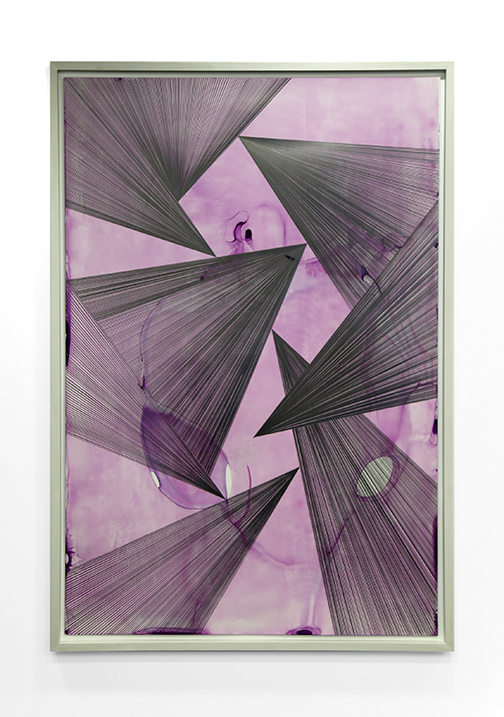
splinter 02/20, 2020
Aquarell und Grafit auf Schichtpapier
121 x 181 cm, gerahmt
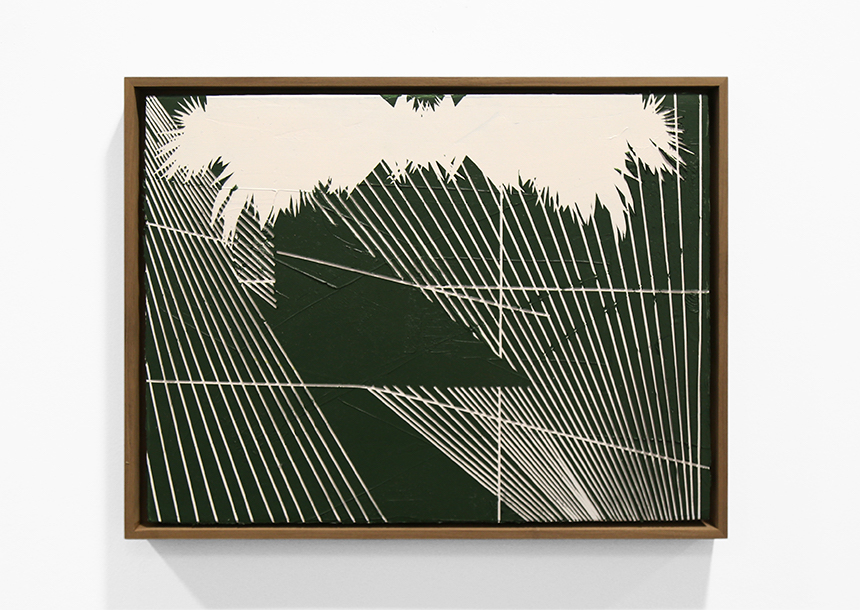
o.T., 2019
Öl auf Leinwand
30 x 40 cm
In his recent works Simon Halfmeyer continues both lines of work that he introduced to the public both in the „Wandzeichnungen“ exhibition (2014) and the „Expetopia“ exhibition (2016): Wilderness in urban space investigated through his figurative drawings and abstraction filling the drawings from edge to edge achieving the impression of an endless „all-over“.
Drawing is the medium of choice to Simon Halfmeyer and he takes it to its limits in different materials and media. The abstract graphite drawings on laminate paper are executed in a format of 181 x 121 cm, rather expected from a painting and by sheer size meeting the observer in a physical eye to eye situation.
His more figurative works are a journey into the wilderness of the urban space. They are derived from an archive of hundreds of drawings and photos reappearing in other works: Palm trees and exotic plants from foyers, greenhouses, airports or shopping malls stand for the artificial construct of wilderness as imagined by civilization. This contrast is made visible through urban elements like sky scrapers or traffic lights.
These drawings are executed either like fresco painting, huge in size and directly on the wall, they can take the form of colour reliefs and are taken into the third dimension as sculptures. One work leads to another, elements are re-used, transformed and later find their way back into the archive their first version derived from. An organic growth through sampling process that is reminiscent of the growth of the jungle these drawings constitute.
The abstract series of „Stars“ more than any other of his reintroduces the „hand of the artist“ into the work. He draws the lines using a ruler in opposition to the organic forms of his plant drawings and forms the rhythm of the drawing by moving the lines bit by bit. A very physical process considering the drawing’s size.
Fadi al Hamwi
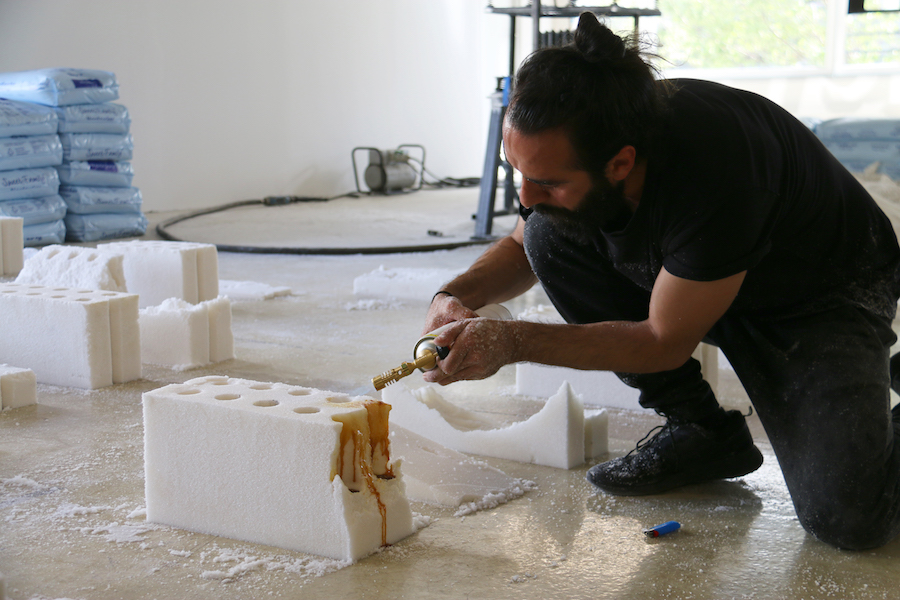
Sugar Forever, 2019
Performance, CAA Berlin
Please click on the image to start the slide show!
Whoever has missed out on Fadi al-Hamwis performance „Sugar Forever“ at CAA gallery, Berlin, in June 2019 is now given the chance for a digital re-evaluation with the photo documentation the artist contributed to STATE OF THE ART.
In about 10 days the artist transformed hundreds of kilos of loose sugar into cubes formed after the traditional building bricks as they are common in Syria. And the sheer dimension of the work is reflective of the situation: To al-Hamwi sugar in this context stands for two closely related aspects forming today’s society, colonialism with its consequences, amongst which migration, be it through people seeking refuge from war or hunger today.
What these dis- and replacements have in common is the need to find a new role and place in the country of arrival. To be part of the bricks that form society, symbolised by the metaphor of building and house. The process is not an easy one. Not all grains of sugar stay in place after the pressing process and there too are destructive forces, burning and melting the sugar bricks. But the majority of the bricks lines up in neat order, all formed by the artists hand as the directing, forming, structuring force.
With this performance Fadi al-Hamwi follows the path that he set in the IN BETWEEN exhibition at galerie postel in 2018/19, where he displayed a book pressed from sugar that read „Poisoned History“ on the title. MIgration, flight, the consequences of integrating in a new society also were reflected in the concrete rug „Irrational Loop of Dust“, two strings of al-Hamwis work, that come together in the latest performance „Sugar Forever“ on display at STATE OF THE ART today.
Sylvia Henze
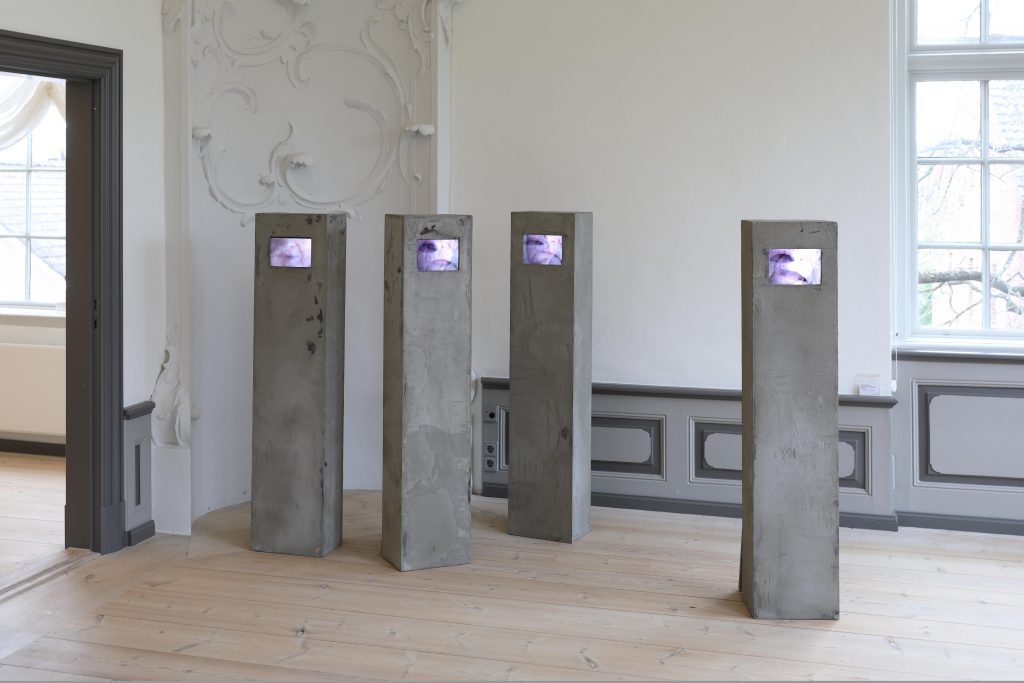
Breaking the Mould, 2015
video installation, 1:21 min. loop
tablet, wood, concrete
146 x 31 x 22 cm
Please click on the image to start the video!
In „Breaking the Mould II“ Sylvia Henze uses close-up cross-fadings of the faces of old women talking about their war time experiences. Who are they? And what happened to them? We do not know, as we cannot capture the person as a whole. Eyes, mouths, wrinkles form a concert of images without giving up the individual they belong to.
Exhibited as a group the idea of a choir of women arises. The visitors focus switches from the individual features of sorrow to war as a mass phenomenon multiplying the individual sufferings.
„Breaking the Mould II“ is the latest work derived from Sylvia Henze’s stay at Nicosia / Cyprus, where she in 2004/05 started an artistic investigation into the town’s division. The results were amongst others a series of photographs and a video on the situation of a family whose house was situated right on the boarder with the absurd effect of a window that was only permitted to be opened for five minutes per hour under the strict observation of UN soldiers. These works were part of the
„Borderlines“ exhibition in 2017.
Sylvia Henze has decided not to include the sound in the video, thereby omitting the regional localization of language transferring it to a universality independent of time and space. This could take place today as much as it could have in 2015 when the work was composed.
The observer focuses on facial expressions, painful memories shining through eyes and mouths, traces of age, memory imprinted in deep rifts cutting through the old skin. Mounted in concrete steles just below eye level, one is forced to bow down and pay one’s respects to gain an unobstructed view of the faces flickering across the electronic displays.
Katharina Kohl
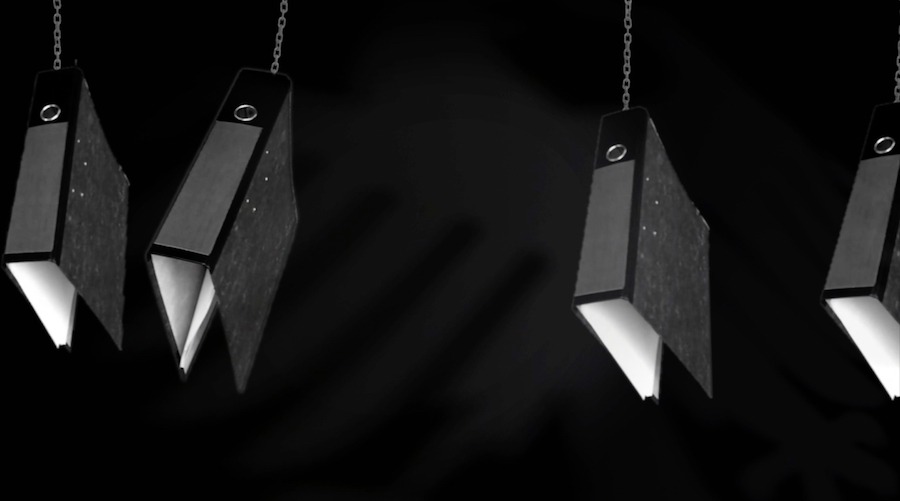
Erinnerungslücken / Innere Sicherheit #2, 2020
video, 4:22:11 min.
The world presenting itself to the viewer of Katharina Kohl’s video „NSU Erinnerungslücken“ (NSU losses of memory) is all black, white and gray. Blackened pages turn noisily on the left side of the video while on the right side waftingly the federal eagle has difficulties manifesting itself in the flawed grey. A mechanical clattering noise sets in, reminiscent of the manual dragging of ancient chain- and gear wheel systems of pulleys.
Slowly ring binders pass by, standardised versions in marbled grey. Photos of such binders became symbolic for the vast amount of pages that formed the protocols of the commission of inquiry that were the source for this work. The blackened pages are taken from the protocol of the second inquiry, with the parts of the text left free where the witnesses referred to their loss of memory. Read out one after the other the choice of words becomes noticeable in all their repetition and turns.
Ring binders at the same time stand for the institutionalization of the filing process that in the investigations into the murders committed by the NSU so often obstructed a clear view of the terrorist group. In 2019 Katharina Kohl exhibited a print of a plastic bag alongside the series of the blackened prints and an investigative installation „Personalbefragung“ (a series of watercolours portraying state personell responsible for the investigation into the murder series). Such a plastic bag was used to „file“ a contact list discovered when searching the garage where the terror group had built the bombs used in the attacks. Carefully stored in a cupboard the contacts never were checked upon, missing out on information that could have led to their arrest.
Danijela Pivašević-Tenner
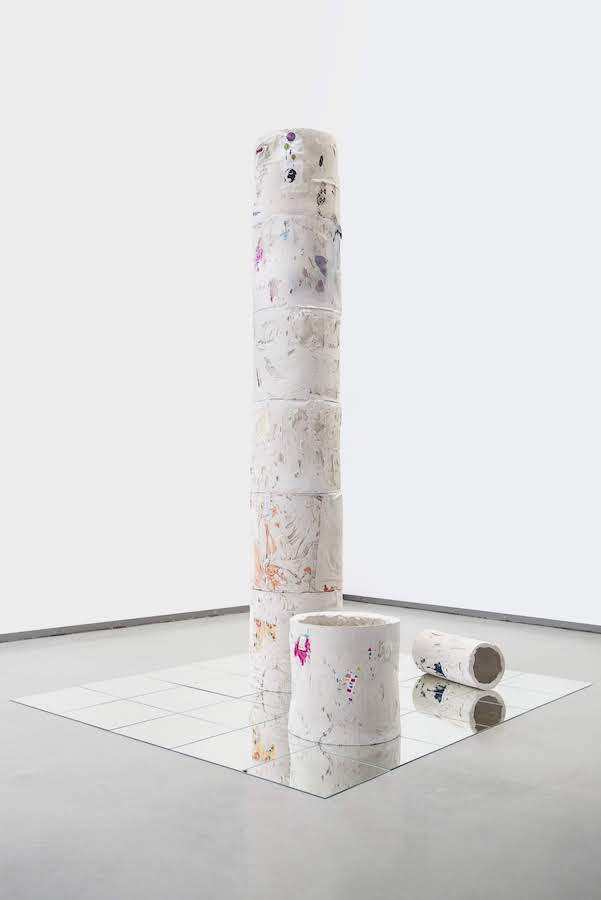
Triumphsäulen, 42 Szenen der Gegenwart
installation at the museum Tuch + Technik, Neumünster 2019
raw porcelain, textiles, mirror tiles
A series of triumphal columns was manufactured by Danijela Pivašević-Tenner for her 2019 exhibition at Neumünster’s museum of art and textile. It was the reason for her to reflect on textiles as a material and the history of the place that had been a prominent location for the textile industry.
Local traditions, social context of an objects use and local manufacturing techniques are a focus of Danijela Pivašević-Tenner’s works that range from deformed vessels to installations as the ones in the
„Dieser Moment“ exhibition at galerie postel.
There, too, everyday objects formed part of her works. Cable ties point to the change of ideas associated with the label „Made in China“ from the white gold of porcelain to plastic as mass product. Historic vessels, furniture, carpet or as in this case textile add to the works meaning, always with porcelain as base and starting point, Danijela Pivašević-Tenners medium of choice.
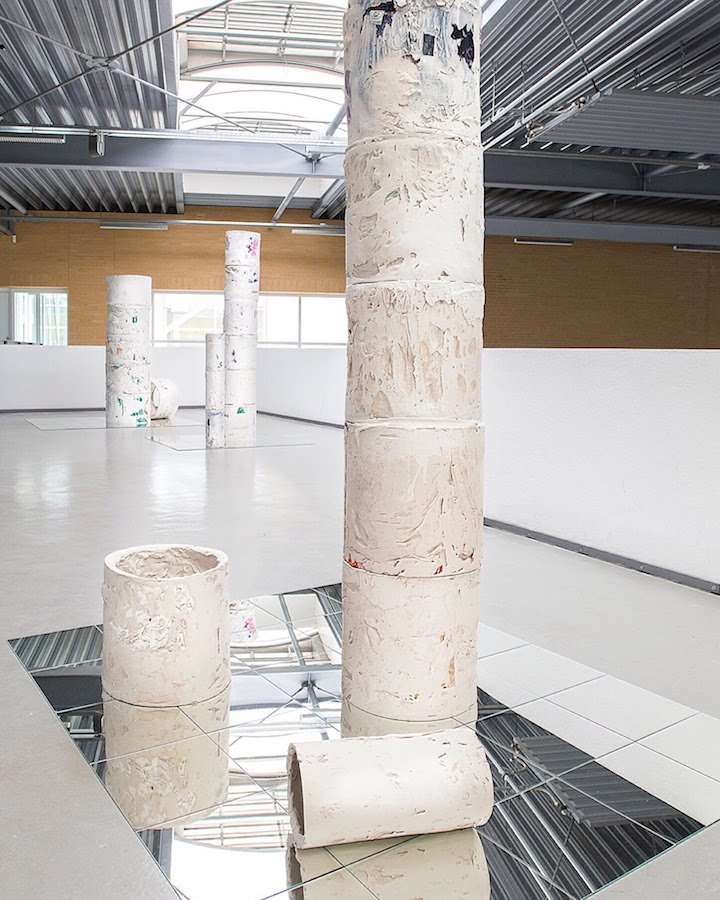
installation view at museum Tuch + Technik, Neumünster 2019
An excerpt from a text by art historian Dr. Susanne Schwertfeger from the 2019 Neumünster catalogue kindly provided by the artist describes central aspects of Danijela Pivašević-Tenner’s work best:
Triumphsäulen – 42 Szenen der Gegenwart [ Textauszug aus dem Katalog “ Danijela Pivašević-Tenner – den Faden aufnehmen“,S. 33-41, ISBN: 978-3-00-063020-0 ]
„Ausgangspunkt für die Arbeit Triumphsäulen – 42 Szenen der Gegenwart sind Textilien aller Art, die von Neumünsteranerinnen und Neumünsteranern gespendet wurden. Generell tun sich viele Menschen damit schwer, sich von Dingen zu trennen. Entgegen aller Trends rund um das Aussortieren und Ausmisten, verknüpfen wir grundsätzlich häufig Gefühle von (materieller) Absicherung, Geborgenheit aber auch Aspekte der eigenen Identität mit Objekten – schließlich ‚machen Kleider Leute‘. […]
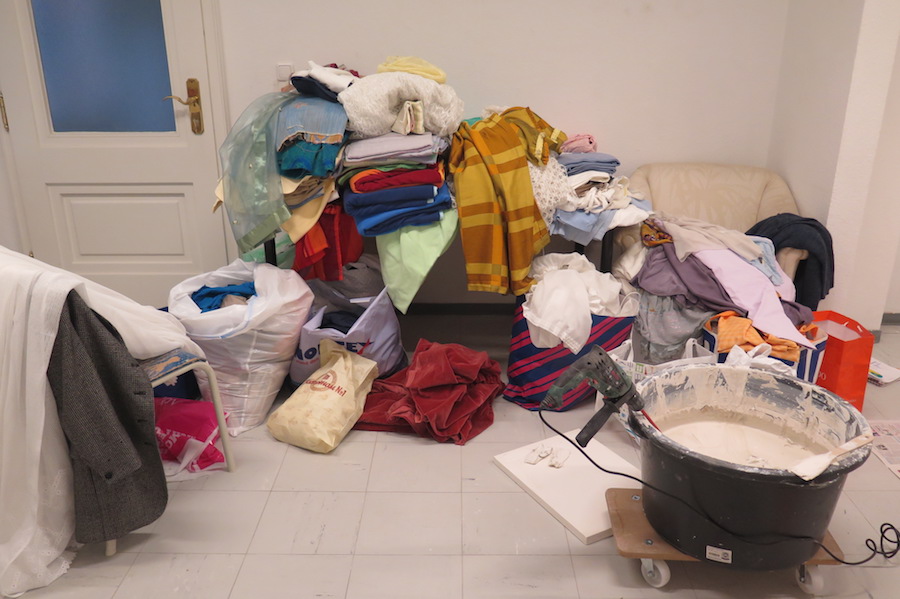
studio view 2019
Nichts geht verloren, und auch die mit den Textilien verknüpften Erinnerungen landen nicht im Müll. Stattdessen wurden sie bei der Übergabe nochmals bewusst von der Künstlerin im Gespräch wachgerufen und mitgeteilt. Die Stoffe und deren Geschichten wurden anschließend zu etwas Neuem transformiert. Sie sind nun, umgossen von Porzellan, Teil der großen und kleinen Säulentrommeln. Wie schon in der klassischen Antike verbinden sich diese einzelnen Segmente zu hochaufragenden Raumelementen. Sie können umwandert und aus der Nähe sowie von innen betrachtet werden. […]
Bereits in der Antike diente figurativer Bildschmuck auf einer Säulenform dem Erzählen und zur Bewahrung von Geschichte. Ein frühes Beispiel findet sich auf dem Trajansforum in Rom […]
Nicht nur aufgrund der Kombination mit Stoffen sind die Säulenfragmente ungebrannt: Das Porzellan ist zu einem grauen, fast ‚banal‘ anmutenden Brei getrocknet, der Risse und Krakelees aufweist und nichts mit der klassisch glänzenden weißen und veredelten Oberfläche gemein hat, die üblicherweise mit dem Werkstoff assoziiert wird. Auf diese Weise geht er eine Allianz mit den gebrauchten, abgelegten Textilien ein und wirft Fragen zur Wertigkeit auf. Wann wird ein Material oder ein Objekt mit Bedeutung aufgeladen – und wann und mit welchen Konsequenzen werden diese wieder entzogen? Für die Triumphsäulen – 42 Szenen der Gegenwart bedeutet die Trocknung, dass sie im Alterungsprozess einer beständigen Transformation unterliegen. Ohne die Aushärtung und Fixierung durch den Brand reagiert das Porzellan auf Umwelteinflüsse, wie beispielsweise die Luftfeuchtigkeit. In letzter Konsequenz besitzt die Arbeit damit das Potential – gemeinsam mit Naturfasern der Stoffe – wieder gänzlich in der Umwelt aufzugehen, loszulassen und Teil des natürlichen Kreislaufs zu werden.“
Razan Sabbagh

Selbstporträt, 2020
Digitalprint 1/30 (2 AP)
auf DIN A2
The emotional consequences of personal experience were reflected upon in Razan Sabbagh’s contribution to the
„IN BETWEEN“ exhibition already „Holding the Memory“ was the concrete cast of a pillow her grandmother from Damascus/Syria had embroidered for her and never was able to hand over after Sabbagh had fled the country. The heavy material was connected to the ceiling via black threads that like bars obstructed the view through the gallery window.
In her latest work Sabbagh examines the effects of Corona-isolation on human relations. The Performance „Small Talk“ consisted of two parts: The first took place during lockdown, when she had one-on-one video meetings with family members, friends and friends of friends. Asking questions concerning their surroundings, smells or the way they felt she led her conversational partners into disclosing personal matters.
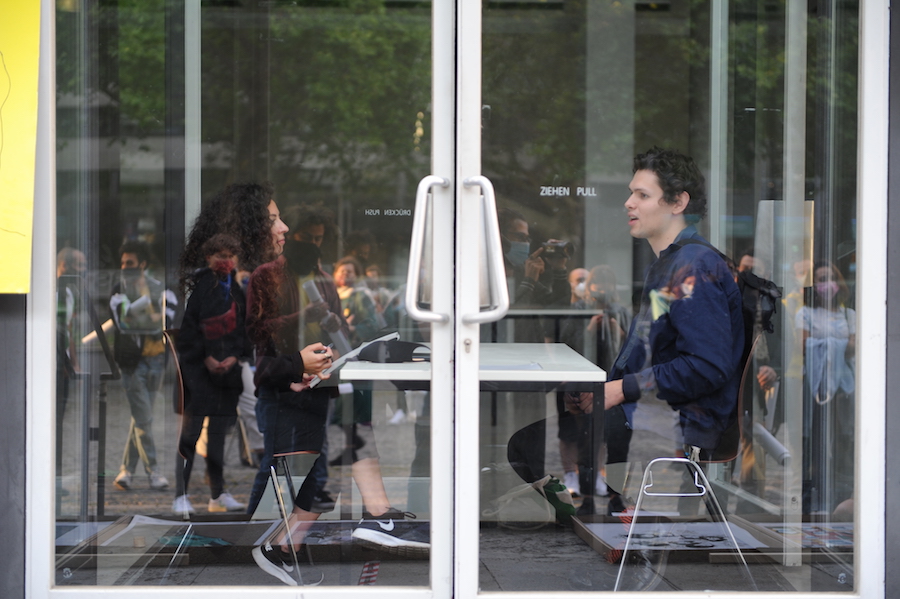
After lockdown Razan Sabbagh repeated these one-on-one talks in real. She met the persons who took part in the performance in a glass space at UDK, where the waiting could observe the conversation that took place inside.
A self portrait Razan Sabbagh took when having a conversation with herself is part of the „STATE OF THE ART“ exhibition. She notes:
„Having more time to sit with ourselves due to social distancing and Lockdown made us think and/or re-think on many thoughts that we never had the time, the real chance, or maybe the courage to pay attention to. This fact has a lot to do with the effects of the pandemic on us, and consequently on the world.“
Richard Schur

Air, 2017
Acrylic on nettle
180 x 140 cm
The painting Richard Schur contributed to the STATE OF THE ART exhibition conforms to a new development visible in his style of painting.
As was the case with paintings
from the Manhattan Stories – series exhibited at galerie postel earlier, Schur chose a title transporting the impression of a mood, situation, or – as often – a phenomenon from the sphere of nature. Composed in the intense seclusion of the studio the composition of colours rather suggests an impression from the artists memory than a proof of reality.
In the last years Richard Schur repeatedly experimented with squares as a form, some of them physically entering the third dimension as relief. Dominated by bright colours and strong contrasts this painting however uses elements that have been part of Richard Schurs tool set for a long time. Different structures of the paintings surface and a careful weighting of different shades of colour.
Bare nettle contrasts with heavy coloured areas, shiny surfaces with matte parts or visible brush-strokes. When contemplating the image intensively, an impression of three-dimensionality occurs. Colours protrude or retreat and create an illusion of space.
Helga Weihs
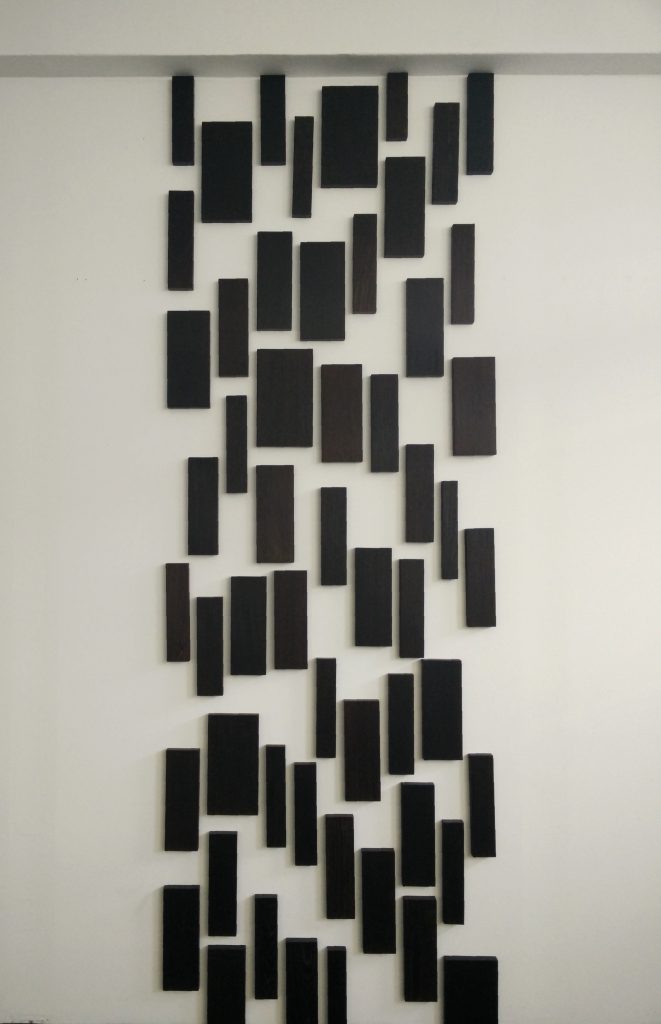
WO-1-2020, 2020
wenge
235 x 80 x 2,2 cm
Please click on the image to start the slide show!
WO – the works title as named by Helga Weihs is just as minimalistic as her approach to it. It stands for „Wall Object“ thereby describing the intended position of the wooden elements. Precisely placed on the wall they take up the floor pattern of the space they were intended for: The galerie postel at its former location at Rutschbahn 2, where it was to take part in the last exhibition in May / June that due to the Covid situation was postponed to take place online only in September – voilà die STATE OF THE ART.
Made from wenge the work reflects colour and structure of the laminate provided by the landlord, that itself was only an imitation of the valuable exotic wood. It frequently is used by the artist and repeatedly was exhibited at galerie postel, as well in the „TRAJEKT“ exhibition as in the more recent „JAPANISCHE ANORDNUNG“.
The subtle positioning of the elements is part of Weihs‘ concrete approach that comments on the space in which the work is placed. The work therefore is adaptable to the space and follows the co-ordinates of thickness and height of the material of the wenge-panels that form the modular system. A variable width of the panels diffuses the system’s rigour.
Consistent with her idea of space and the movement of observers through space as contributing to the experience of it, Helga Weihs prepared a series of photographs of the sculpture for the online exhibition: They enable the visitor to follow her movement in front of the real work and experience the shifting perspectives.
Thank you for visiting STATE OF THE ART!
Please contact us for further information:
kontakt (at) galeriepostel.de
Tel.: +49-40-22 85 39 24 – 0
















